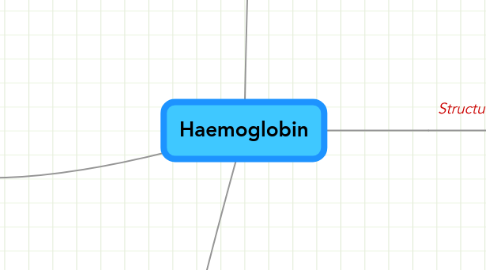
1. Different Heamoglobins
1.1. Different haemoglobins have different affinities for oxygen because of their slightly different shapes. They can be made of a different amino acid sequence meaning that the shape will differ, this means that their affinty for oxygen will also change.
1.1.1. Heams. with high affinity for O2
1.1.1.1. Take up oxygen easily, Releases it less readily
1.1.1.1.1. An organism that lives in an environment with little oxygen needs a heamoglobin that readily takes up oxygen. Provided metabolic rate is low, the fact that the haemoglobin does not release oxygen readily is not a problem.
1.1.2. Haems. with low affinity for O2
1.1.2.1. Takes up oxygen less readily Releases it more readily
1.1.2.1.1. An organism with high metabolic rate needs to release oxygen into respiring tissues faster. Provided that the organism lives in an evironment with plenty of oxygen, it is not a problem that the heamoglobin takes up oxygen less readily.
2. Oxygen Dissociation Curves(O.D.Cs)
2.1. O.D.Cs show the relationship between the partial pressure of oxygen and the saturation of haemoglobin with oxygen. Different curves show different heamoglobins and their affinity to oxygen
2.1.1. The further to the left the curve, the greater is the affinity of heamoglobin for oxygen. (e.g lug worms because they live in an oxygen deprived environment) This means that the heamoglobin will become saturated faster at lower pressures of oxygen.
2.1.2. Example
2.1.3. The further to the right the curve the lower the affinity of the haemoglobin for oxygen.(e.g mouses, because they live in an oxygen rich environment) This means that the haemoglobin will only upload oxygen at a higher partial pressure of oxygen.
2.2. Effects of CO2 concentration
2.2.1. The greater the levels of CO2 and less O2 the less readily the heam. will take up oxygen(moving the curve to the right). The CO2 changes the shape of the heamoglobin causing it to release the O2 (Bohr Effect). In respiring tissues levels of CO2 are high and so the heamoglobin will release its oxygen to raise the O2 levels in the tissues.
2.2.2. The less CO2 there is in the environment the more readily the heamoglobin will take up the oxygen.(moving the curve to the left). at gas exchange surface(e.g lungs) CO2 levels are low, and oxygen concentration is very high. The shape of the heamoglobin is now more suited to take up the oxygen and keep hold of it
3. Role of Haemoglobin
3.1. to transport oxygen
3.2. needs to readily associate with oxygen at the surface where gas exchange occurs
3.3. readily dissociate oxygen at those tissues requiring it
3.4. Haemogobin changes shape to take up and release oxygen in the presence of certain substances. E.G CO2 causes haem. to change shape and relase oxygen into respiring cells.
4. Structure of haemoglibin
4.1. Primary structure
4.1.1. Consists of four polypeptide chains
4.2. Secondary structure
4.2.1. Each of these chains is coiled into a helix
4.3. Tertiary structure
4.3.1. In which each polpeptide chain is folded into a precise shape-very important to be able to carry oxygen
4.4. Quaternary structure
4.4.1. All four polypedtide chains are linked together to form a spherical molecule. Each chain is associated with a haem group. Each Fe+ ion combines with one oxygen molecule.
